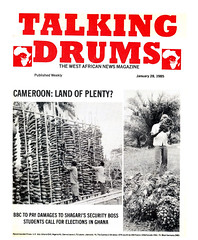Senegal's renewable energy research centre
By Amadou Dieng
The institute was subsequently named the Henri Masson Institute, in honour of the first dean of Dakar University's Science Faculty, who was one of the first people to realise that there could be no development without research. As a result of its rigorous and wide-ranging research work, the Henri Masson Institute soon became one of the country's leading research bodies, and its reputation spread beyond Senegal's frontiers.
Three years ago, the institute had expanded to such an extent that it was turned into a fully-fledged university institute and given a new name, the Renewable Energy Study and Research Centre (CERER).
All research undertaken by the centre is geared to the needs of the rural world. It is mainly focussed on the problem of how to obtain water. The main line of research concerns the development of solar pumps or solar motor-pumps, which use the energy from sunlight to extract water from the ground.
This research programme aims essentially to solve water problems in villages and pastoral areas. For despite efforts already made by the Senegalese government, especially in the wooded and pastoral zone where most of the country's livestock is concentrated, the problem of water is still a relatively urgent one for the human and animal population, particularly at a time when a long-term drought seems to have set in.
The programme has been given top priority by the government, which has, moreover, worked out and begun to implement a national water plan. Thanks to CERER's research, there are now many solar pumping stations in rural areas; the centre has also helped to set up wind-powered pumping stations.
CERER, which has achieved spectacularly good results from the programme, has chosen as its second line of research the use of solar energy to preserve foodstuffs by drying. It has concentrated its efforts on developing a solar fish-drying plant. Senegal has enormous fishing resources, but preservation techniques are for the most part rudimentary, and result in a wastage rate of 40 to 60 per cent. Whereas both self-employed fishermen and the fishing industry use modern equipment, catches are in the region of 380,000 to 400,000 tonnes a year.
If that production is to be properly used, proper processing techniques must exist. CERER has therefore developed solar fish-drying plants for a number of fishing co-operatives, with the result that the end-product is not only obtained more quickly, but is of higher quality.
The exploitation of solar energy is expensive, but, through photovoltaic techniques which enable the sun's rays to be converted directly into electric current, Senegal is determined to arm itself with a wide range of possible options in the sphere of solar energy.
The success of this venture encouraged CERER to install a giant 100-square-metre solar fish-drying plant in N'Guet N'Dar, a fishermen's district of Saint-Louis, the former Senegalese capital and now administrative centre of the northern region. Other projects have been carried out on the "Little Coast", in the region of Thiès, and in other places where there is organised fishing.
A third line of research undertaken by CERER has been the development of solar water-heaters, with the aim of making them economic enough to replace electric water-heaters. The government has set up the "Albert Daguerre" Industrial Company for the Application of Solar Energy (SINAES) and given it the task of popularising such equipment, which is for the moment being offered at a special low price. All such action is aimed at meeting the challenge of the energy crisis.
Senegal intends to prove, through the implementation of these various programmes, that efficient use of locally available energy is one of the solutions to that energy crisis. The exploitation of solar energy is expensive, but, through photovoltaic techniques which enable the sun's rays to be converted directly into electric current, Senegal is determined to arm itself with a wide range of possible options in the sphere of solar energy The expert view is that such methods will never be able to meet major need but for small schemes involving isolated villages, photovoltaic techniques are certain to prove not only useful, but economic. 40 per cent fuel savings Senegal has taken the bold step seeking solutions in the sphere thermodynamics as well: its sole power station at Diakhao (in Kaolack region), which was built under the aegis of the National Electrical Energy Company, is the first of its kind in Africa. It shows that thermodynamic principles, too, can offer viable solutions. Unlike photovoltaic techniques, thermodynamics makes it possible to produce electricity without converting solar energy. Although expensive solution for large-scale development schemes, it does offer answers to the energy problem faced by the developing countries.
But above all CERER is focussing attention on the way the biomass, and more particularly wood, is being used at a time when the process of desertification is gathering pace. Sixty percent of CERER's work involves the development and distribution of improved cooking fires known as "Bank ak Suuf" (clay and sand) stoves. This is one way of exploiting local resources by using local materials (clay and sand); it also relies on endogenous technique that is straightforward, easily accepted, and above a so inexpensive that it can be afforded by even the poorest families. At present, there are over 20,00 such improved stoves in rural area The Senegalese government has set u a 250 million Central African France programme aimed at distributing 300,000 to 400,000 such stoves, which save between 30 and 40 percent fire wood, as part of the fight against desertification. In this way, what remains of Senegal's forests may be saved. The traditional "three-stone fireplace" wastes considerable amounts of energy. The improved cooking fire programme also forms part of the campaign for energy saving The United States Agency for International Development has given much support to the programme by, for example, funding training centres in various other villages.
